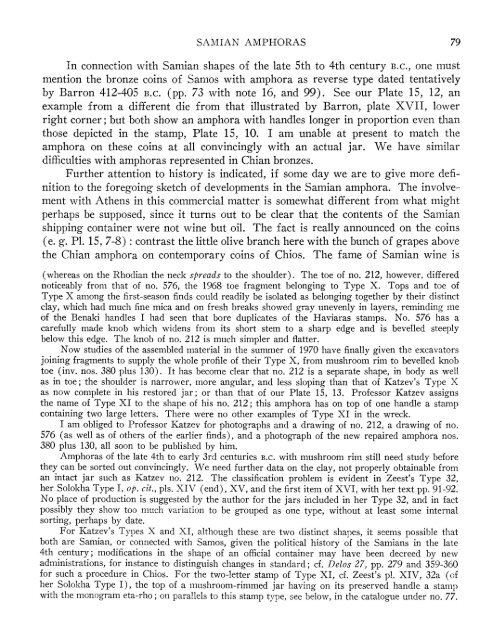SAMIAN AMPHORAS - The American School of Classical Studies at ...
SAMIAN AMPHORAS - The American School of Classical Studies at ...
SAMIAN AMPHORAS - The American School of Classical Studies at ...
You also want an ePaper? Increase the reach of your titles
YUMPU automatically turns print PDFs into web optimized ePapers that Google loves.
<strong>SAMIAN</strong> <strong>AMPHORAS</strong> 79<br />
In connection with Samian shapes <strong>of</strong> the l<strong>at</strong>e 5th to 4th century B.c., one must<br />
mention the bronze coins <strong>of</strong> Samos with amphora as reverse type d<strong>at</strong>ed tent<strong>at</strong>ively<br />
by Barron 412-405 B.C. (pp. 73 with note 16, and 99). See our Pl<strong>at</strong>e 15, 12, an<br />
example from a different die from th<strong>at</strong> illustr<strong>at</strong>ed by Barron, pl<strong>at</strong>e XVII, lower<br />
right corner; but both show an amphora with handles longer in proportion even than<br />
those depicted in the stamp, Pl<strong>at</strong>e 15, 10. I am unable <strong>at</strong> present to m<strong>at</strong>ch the<br />
amphora on these coins <strong>at</strong> all convincingly with an actual jar. We have similar<br />
difficulties with amphoras represented in Chian bronzes.<br />
Further <strong>at</strong>tention to history is indic<strong>at</strong>ed, if some day we are to give more defi-<br />
nition to the foregoing sketch <strong>of</strong> developments in the Samian amphora. <strong>The</strong> involve-<br />
ment with Athens in this commercial m<strong>at</strong>ter is somewh<strong>at</strong> different from wh<strong>at</strong> might<br />
perhaps be supposed, since it turns out to be clear th<strong>at</strong> the contents <strong>of</strong> the Samian<br />
shipping container were not wine but oil. <strong>The</strong> fact is really announced on the coins<br />
(e. g. PI. 15, 7-8) : contrast the little olive branch here with the bunch <strong>of</strong> grapes above<br />
the Chian amphora on contemporary coins <strong>of</strong> Chios. <strong>The</strong> fame <strong>of</strong> Samian wine is<br />
(whereas on the Rhodian the neck spreads to the shoulder). <strong>The</strong> toe <strong>of</strong> no. 212, however, differed<br />
noticeably from th<strong>at</strong> <strong>of</strong> no. 576, the 1968 toe fragment belonging to Type X. Tops and toe <strong>of</strong><br />
Type X among the first-season finds could readily be isol<strong>at</strong>ed as belonging together by their distinct<br />
clay, which had much fine mica and on fresh breaks showed gray unevenly in layers, reminding me<br />
<strong>of</strong> the Benaki handles I had seen th<strong>at</strong> bore duplic<strong>at</strong>es <strong>of</strong> the Haviaras stamps. No. 576 has a<br />
carefully made knob which widens from its short stem to a sharp edge and is bevelled steeply<br />
below this edge. <strong>The</strong> knob <strong>of</strong> no. 212 is much simpler and fl<strong>at</strong>ter.<br />
Now studies <strong>of</strong> the assembled m<strong>at</strong>erial in the summer <strong>of</strong> 1970 have finally given the excav<strong>at</strong>ors<br />
joining fragments to supply the whole pr<strong>of</strong>ile <strong>of</strong> their Type X, from mushroom rim to bevelled knob<br />
toe (inv. nos. 380 plus 130). It has become clear th<strong>at</strong> no. 212 is a separ<strong>at</strong>e shape, in body as well<br />
as in toe; the shoulder is narrower, more angular, and less sloping than th<strong>at</strong> <strong>of</strong> K<strong>at</strong>zev's Type X<br />
as now complete in his restored jar; or than th<strong>at</strong> <strong>of</strong> our Pl<strong>at</strong>e 15, 13. Pr<strong>of</strong>essor K<strong>at</strong>zev assigns<br />
the name <strong>of</strong> Type XI to the shape <strong>of</strong> his no. 212; this amphora has on top <strong>of</strong> one handle a stamp<br />
containing two large letters. <strong>The</strong>re were no other examples <strong>of</strong> Type, XI in the wreck.<br />
I am obliged to Pr<strong>of</strong>essor K<strong>at</strong>zev for photographs and a drawing <strong>of</strong> no. 212, a drawing <strong>of</strong> no.<br />
576 (as well as <strong>of</strong> others <strong>of</strong> the earlier finds), and a photograph <strong>of</strong> the new repaired amphora nos.<br />
380 plus 130, all soon to be published by him.<br />
Amphoras <strong>of</strong> the l<strong>at</strong>e 4th to early 3rd centuries B.C. with mushroom rim still need study before<br />
they can be sorted out convincingly. We need further d<strong>at</strong>a on the clay, not properly obtainable from<br />
an intact jar such as K<strong>at</strong>zev no. 212. <strong>The</strong> classific<strong>at</strong>ion problem is evident in Zeest's Type 32,<br />
her Solokha Type I, op. cit., pls. XIV (end), XV, and the first item <strong>of</strong> XVI, with her text pp. 91-92.<br />
No place <strong>of</strong> production is suggested by the author for the jars included in her Type 32, and in fact<br />
possibly they show too much vari<strong>at</strong>-ion to be grouped as one type, without <strong>at</strong> least some internal<br />
sorting, perhaps by d<strong>at</strong>e.<br />
For K<strong>at</strong>zev's Types X and XI, although these are two distinct shapes, it seems possible th<strong>at</strong><br />
both are Samian, or connected with Samos, given the political history <strong>of</strong> the Samians in the l<strong>at</strong>e<br />
4th century; modific<strong>at</strong>ions in the shape <strong>of</strong> an <strong>of</strong>ficial container may have been decreed by new<br />
administr<strong>at</strong>ions, for instance to distinguish changes in standard; cf. Delos 27, pp. 279 and 359-360<br />
for such a procedure in Chios. For the two-letter stamp <strong>of</strong> Type XI, cf. Zeest's pl. XIV, 32a (<strong>of</strong><br />
her Solokha Type I), the top <strong>of</strong> a mushroom-rimmed jar having on its preserved handle a stamp<br />
with the monogram eta-rho; on parallels to this stamp type, see below, in the c<strong>at</strong>alogue under no. 77.

















